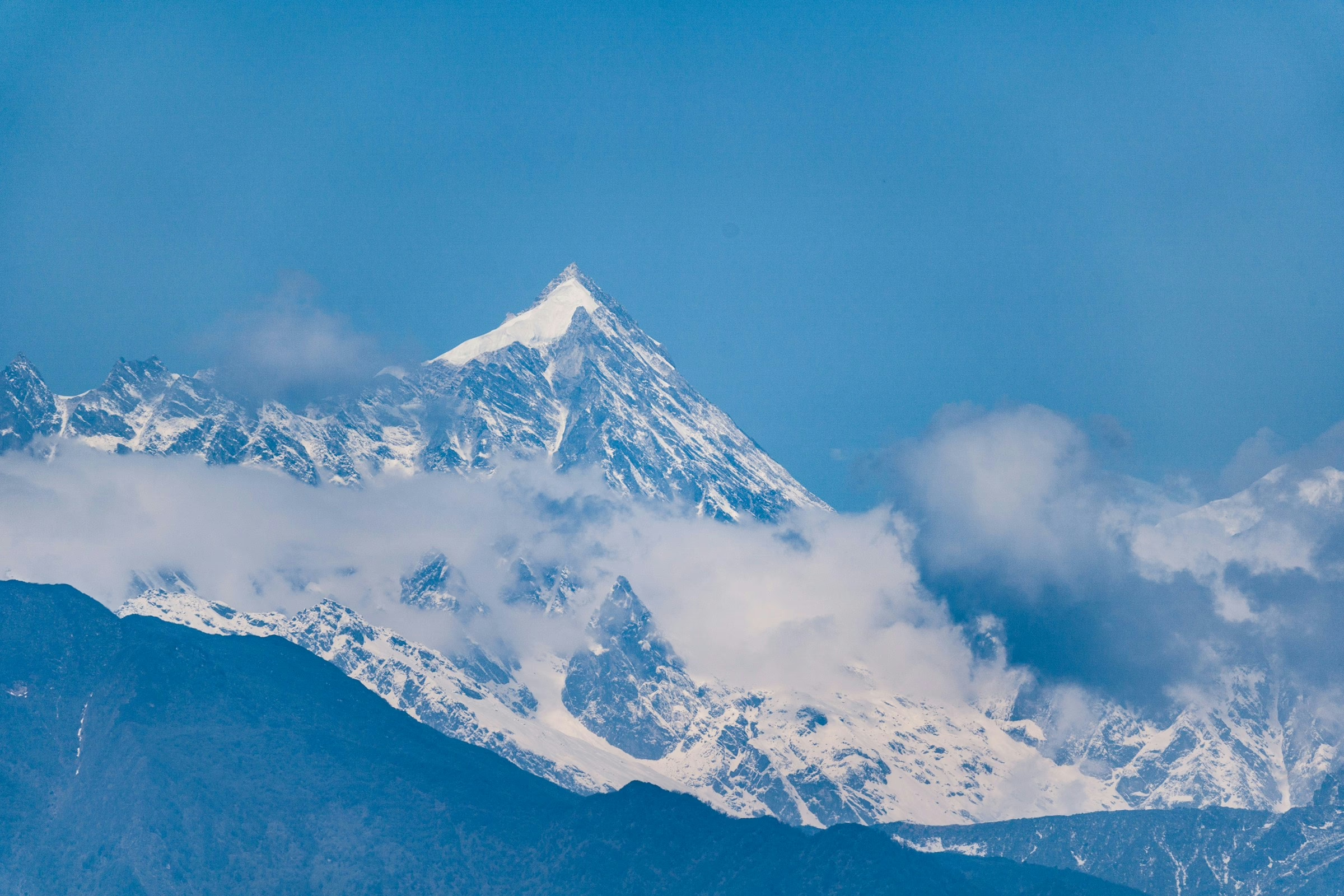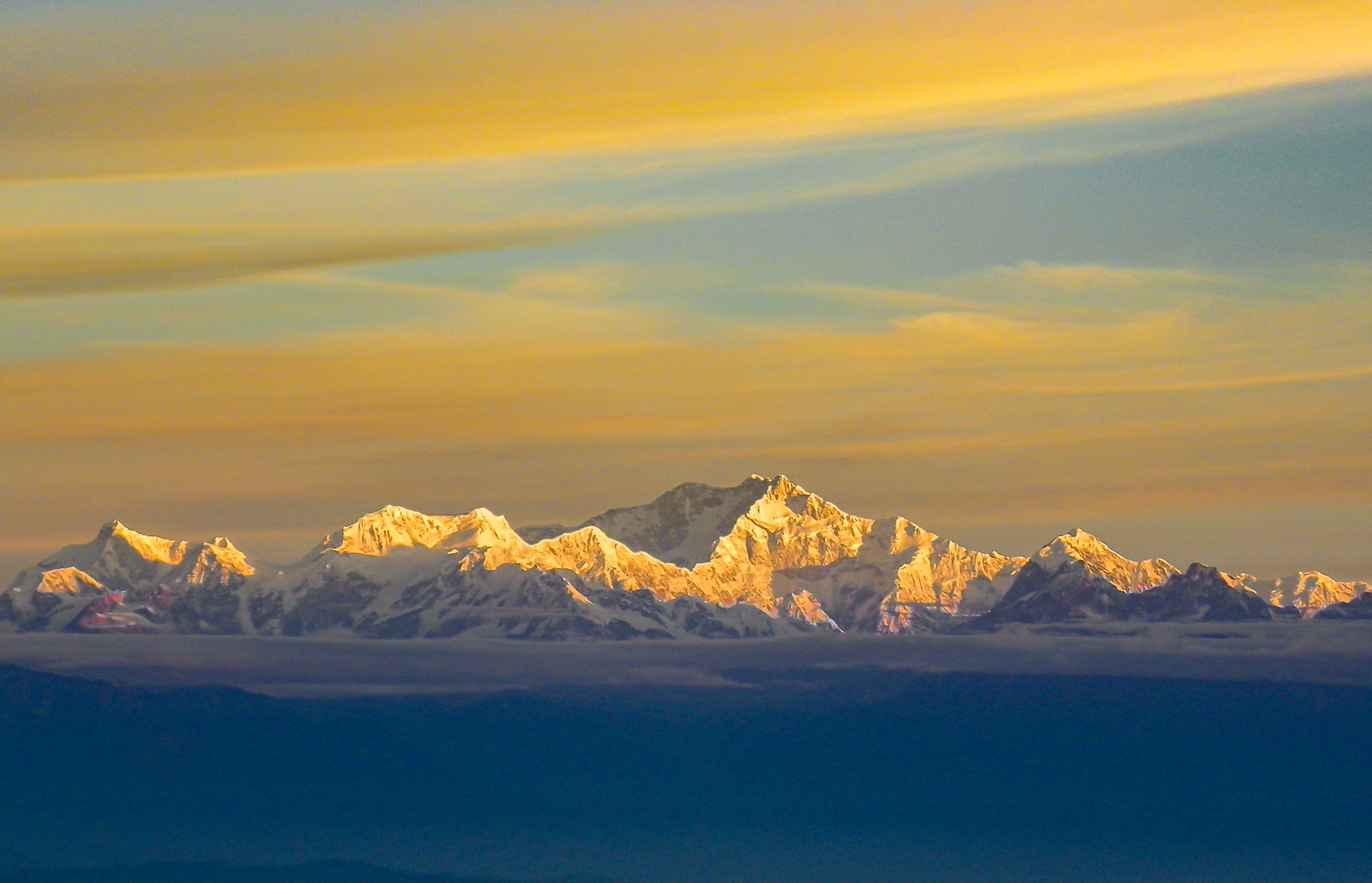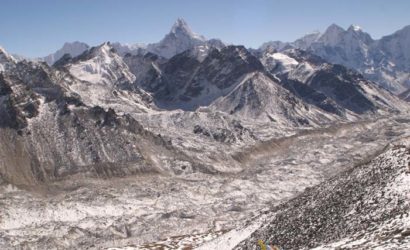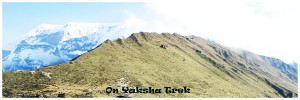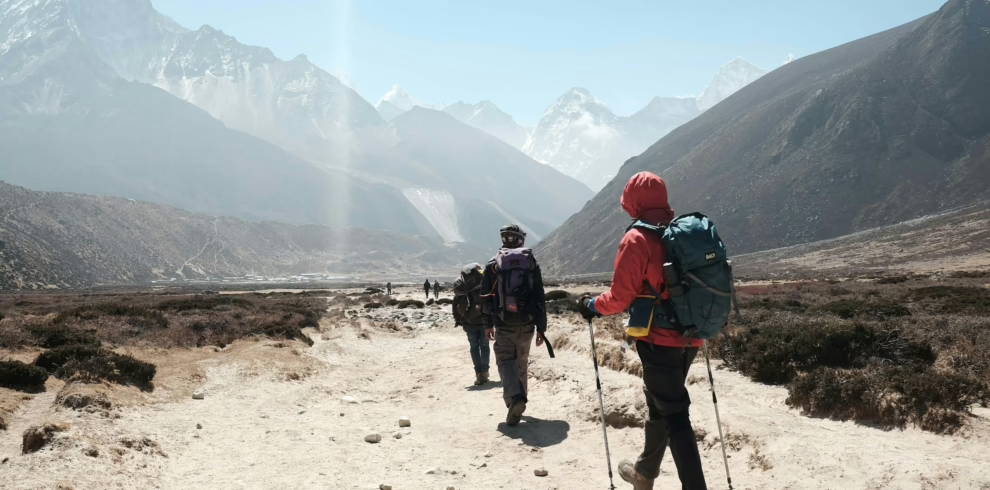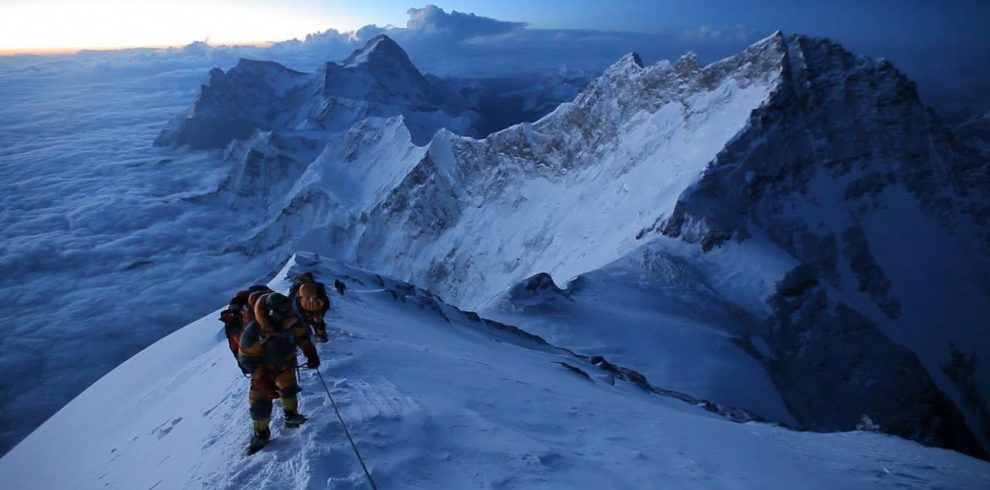Far from the crowded trails of Everest and Annapurna lies one of Nepal’s best-kept secrets—the Kanchenjunga South Base Camp Trek. This off-the-beaten-path adventure takes you deep into the eastern Himalayas, where raw natural beauty, cultural richness, and genuine solitude await. Towering at 8,586 meters, Kanchenjunga, the world’s third-highest peak—revered locally as the “Five Treasures of Snow”—commands awe and respect at every turn.
As you journey through this wild terrain, you’ll pass through the heart of the Kanchenjunga Conservation Area, a protected haven for rare wildlife and unique ecosystems. Here, nature thrives in its purest form—red pandas, snow leopards, and Himalayan black bears call this region home, while vibrant butterflies and birds fill the air. In spring, forests explode with color as rhododendrons bloom, creating a vivid contrast against the snow-capped peaks.
Beyond its natural wonders, the trek is a cultural immersion. Wind through remote villages inhabited by the Rai and Limbu people, whose rich traditions and warm hospitality make every encounter meaningful. Learn about their ancient customs, visit sacred monasteries and shrines, and witness a way of life that has remained unchanged for generations.
Throughout the route, you’ll be treated to breathtaking vistas of some of the Himalayas’ most iconic giants—including Kanchenjunga, Makalu, and Lhotse. This trek offers not only physical challenge and natural beauty, but also a deep connection to the land and its people.
Overview
The Kanchenjunga South Base Camp Trek is one of Nepal’s most remote and challenging treks, ideal for adventurous trekkers seeking solitude and a true wilderness experience. Unlike the busier routes of Everest and Annapurna, this trail remains largely untouched, offering a peaceful journey through pristine Himalayan landscapes.
As you approach base camp, the terrain becomes increasingly rugged, with steep ascents and descents. Despite the physical demands, the effort is well rewarded with sweeping views of Kanchenjunga—the world’s third-highest peak—and its majestic neighbors.
Due to its high altitude and tough terrain, this trek requires excellent physical fitness and mental preparation. Proper acclimatization and readiness are essential for a successful and enjoyable journey.
The adventure begins with a scenic flight from Kathmandu to Bhadrapur, followed by a 5–6 hour drive to Ilam. From there, you’ll travel to Taplejung, the trek’s starting point. The trail leads through lush subtropical forests to Lali Kharka and Khesewa, then continues through serene woodlands and across small creeks to Phumphe Danda. A suspension bridge crossing brings you to Yamphuding.
From Yamphuding, the route climbs through terraced fields and green meadows to Torongding, then follows the Simbuwa Khola toward Cheram (Tseram). After passing through Oklang and Ramche, you’ll finally reach the awe-inspiring Kanchenjunga South Base Camp.
The return journey retraces the route via Torongding, descending along the Simbuwa Khola to Lamite Bhanjyang and continuing through Yamphuding, Phumphe Danda, and Simbu to Ranipul. From there, you’ll drive back to Bhadrapur and fly to Kathmandu, completing the adventure.
At Green Lotus Trekking Pvt. Ltd, we’re proud to offer a carefully crafted Kanchenjunga South Base Camp Trek Itinerary for 2025 and 2026. The trek can be customized to match your schedule, budget, and fitness level. For details on pricing and availability, feel free to reach out to us.
Interested in exploring more of the Kanchenjunga region? We also offer the Kanchenjunga North Base Camp Trek and the Kanchenjunga Circuit Trek for those seeking a longer or more varied experience.
Why Book the Kanchenjunga South Base Camp Trek with Us?
- Airport transfers (international and domestic)
- Complimentary Green Lotus Trekking duffle bag and T-shirt
- Free trekking map of Kanchenjunga South Base Camp
- Oximeter to monitor blood oxygen levels
- Medical kit for emergencies
- Free luggage storage at our Kathmandu office during the trek
What to Expect from the Kanchenjunga South Base Camp Trek?
The Kanchenjunga South Base Camp Trek is a challenging yet unforgettable Himalayan adventure. Here’s what makes it special:
- Stunning Mountain Views: Enjoy panoramic views of towering peaks like Kanchenjunga (8,586m), Makalu, and Lhotse.
- Diverse Landscapes: Trek through lush forests, remote villages, and glacial rivers.
- Cultural Immersion: Pass through Rai and Limbu villages, interact with locals, and experience their warm hospitality and unique traditions.
- Rich Biodiversity: Spot various birds, butterflies, and rare wildlife like red pandas and snow leopards. In spring, rhododendrons bloom in vibrant colors.
- Challenging Terrain: Trekking involves long days of walking and crossing high passes. With proper preparation, it’s achievable for anyone with moderate fitness.
- Authentic Lodging: Stay in local teahouses offering simple but comfortable accommodations and hearty, energy-packed meals.
- Off-the-Beaten-Path: Enjoy the peace and solitude of a less crowded trekking route.
Is This Trek Right for You?
Before booking, consider these key points:
- Fitness: You’ll need to walk for several hours daily on rugged terrain. Prior training (like hiking or cardio workouts) is highly recommended.
- Altitude: The trek reaches 5,160 meters. Acclimatization and precautions are essential to avoid altitude sickness.
- Experience: Prior trekking or camping experience is helpful but not mandatory.
- Budget: Ensure your budget covers permits, transport, gear, food, lodging, and other trek-related costs.
- Time Commitment: The trek takes 15–20 days. Factor in travel time to and from the trailhead.
- Weather: The best seasons are October–November and March–April. Be prepared for cold, wet conditions at higher elevations.
Preparing for the Kanchenjunga South Base Camp Trek
Success starts with solid preparation. Here’s how to get ready:
- Train in Advance: Build endurance with cardio and strength training several months before the trek.
- Acclimatize Properly: Hydrate, rest, and take it slow to adjust to high altitudes.
- Pack the Essentials: Bring warm layers (down jacket, fleece, hat), quality trekking boots, a sturdy backpack, sleeping bag, rain gear, headlamp, and a first-aid kit.
- Get Travel Insurance: Choose a policy that includes high-altitude trekking, emergency evacuation, and trip cancellations.
- Secure Permits: You’ll need a TIMS card and the Kanchenjunga Conservation Area Permit. Get them in Kathmandu or via your trekking agency.
- Hire a Guide and Porter: They’ll enhance your safety and experience. Choose a reputable agency that treats staff fairly.
- Budget Wisely: Plan for transportation, permits, guides, accommodation, and meals. Having a financial cushion helps you trek stress-free.
Useful Information for Kanchenjunga South Base Camp Trek
Best Time for the Kanchenjunga South Base Camp Trek
The ideal seasons for the Kanchenjunga South Base Camp trek are spring (March–May) and autumn (September–November), offering stable weather, clear skies, and accessible trails.
- Spring (Mar–May): The most popular season with warm temperatures, blooming rhododendrons, and great mountain views.
- Autumn (Sep–Nov): The best overall time to trek—mild temperatures, dry conditions, and excellent visibility.
- Winter (Dec–Feb): Very cold with a high risk of snow and avalanches. Suitable only for experienced trekkers prepared for extreme conditions.
- Summer/Monsoon (Jun–Aug): Heavy rainfall, leeches, and slippery trails make this the least favorable season due to landslide and flood risks.
While spring and autumn are optimal, your timing may depend on personal preference and trekking experience.
Meals on the Kanchenjunga South Base Camp Trek
Food supplies are transported by porters or yaks due to the remote nature of the region. While some vegetables are locally grown, most essentials like rice and grains are brought in.
- Lower elevations: Expect a mix of Nepali and basic Western dishes like pizza, spaghetti, and dumplings.
- Higher elevations: Meals become simpler and more limited. Dal Bhat (rice with lentils and vegetables) is the staple.
Meal Examples:
- Breakfasts (12): Pancakes, oatmeal, muesli, eggs (omelets, boiled), Tibetan or buckwheat bread, often served with honey, jam, or apples.
- Lunches (13): Dal Bhat, soups, dumplings, spring rolls, pasta, pizza, thukpa, tenduk, and more.
- Dinners (12): Similar to lunch, with Sherpa stew, salads, and a variety of noodle and rice-based dishes.
Proper nutrition is essential to fuel your body for the high-altitude trek.
Accommodation on the Trek
Accommodation options vary depending on the location along the route:
- Tea Houses: Basic lodges in villages offer simple rooms with twin beds and shared bathrooms. Hot showers may be available.
- Campsites: Used in higher, more remote areas. Tents, cooks, and kitchen staff can be arranged for a comfortable camping experience.
- Homestays: Provide an immersive cultural experience with basic facilities and warm local hospitality.
Book in advance during peak seasons to secure a place.
Trek Difficulty Level
The Kanchenjunga South Base Camp trek is considered challenging due to its remote terrain, high altitude, and long trekking days.
- Fitness: Good physical condition is essential. Expect steep climbs and 5–8 hours of walking per day.
- Altitude: The base camp reaches 5,130 meters. Acclimatization is crucial to avoid altitude sickness.
- Trail Conditions: Some trails are rough and rocky, especially near passes and at higher elevations.
- Weather: Conditions can change rapidly—be prepared for cold, wind, snow, and rain.
- Experience: Recommended for experienced trekkers with high-altitude trekking background. Basic navigation and camping knowledge are beneficial.
Travel Insurance Requirements
Travel insurance is mandatory due to the trek’s remote and high-altitude nature. Your policy should include:
- High-altitude trekking coverage
- Emergency evacuation (helicopter rescue)
- Trip cancellation/interruption
- Medical expenses
- Loss/theft/damage of personal belongings
Choose a plan tailored for high-altitude adventure trekking.
Altitude Sickness & Remedies
Altitude sickness (AMS) is a risk above 2,500 meters. To prevent and manage it:
- Ascend gradually: Follow a slow itinerary to allow acclimatization.
- Hydration: Drink plenty of water; avoid alcohol and caffeine.
- Rest days: Include acclimatization stops during the trek.
- Medication: Consider Diamox (under medical advice).
- Symptoms: Watch for headaches, nausea, dizziness, fatigue. If symptoms worsen, descend immediately.
- Oxygen: Portable oxygen canisters are advisable in emergencies.
Packing List and Gear
Pack smart for remote, high-altitude trekking. Essentials include:
- Backpack (50–70L) with waist/chest straps
- Sleeping bag: Four-season rated
- Tent: If camping
- Clothing: Down jacket, thermals, fleece, waterproofs, gloves, hat, and sturdy trekking boots
- Headlamp
- First-aid kit
- Water purification system: Filter or tablets
- Sun protection: Sunglasses, sunscreen, hat
- Other gear: Trekking poles, camera, knife, map, compass
Also refer to a detailed Nepal trekking packing list for additional suggestions.
Guide & Safety
Hiring a guide significantly enhances safety, navigation, and cultural experience.
- Local expertise: Guides are familiar with the trail, terrain, and culture.
- Emergency preparedness: Trained in first aid and safety protocols.
- Trail navigation: Helps avoid difficult or dangerous sections.
- Logistics: Arranges food, lodging, and permits.
- Communication: Bridges language barriers with locals.
A guide adds security, insight, and convenience—highly recommended.
Booking Procedure
Book the Kanchenjunga South Base Camp Trek with Green Lotus Trekking, a fully licensed and registered operator (Reg. No. 71671/066/067), affiliated with NTB, TAAN, NMA, and KEEP.
To confirm your trek:
- Pay a 10% deposit online
- Settle the balance upon arrival
Join the Green Lotus Trekking family for an unforgettable Himalayan adventure.
Highlights
- Enjoy panoramic views of towering Himalayan peaks, including Kanchenjunga—the world’s third-highest mountain—as well as Makalu, Lhotse, and other majestic summits.
- Trek through diverse landscapes, from lush forests and glacial rivers to remote mountain villages.
- Pass through traditional Rai and Limbu settlements, offering rich cultural encounters, local hospitality, and insights into unique customs and traditions.
- Discover the region’s biodiversity, with sightings of birds, butterflies, and wildlife, along with a wide variety of flora, including vibrant rhododendron blooms in spring.
- Tackle a physically demanding route involving daily long walks and high pass crossings—achievable with moderate fitness and proper preparation.
- Stay in local tea houses, experiencing authentic Nepalese lifestyle and cuisine. Accommodations are basic yet comfortable, and meals are hearty and energizing.
- Escape the crowds on this off-the-beaten-path trek, perfect for those seeking solitude and unspoiled Himalayan beauty.
- Visit ancient Hindu and Buddhist monasteries, adding a spiritual dimension to the journey. For Buddhists, the Kanchenjunga range is a sacred pilgrimage site believed to be the abode of deities.
- Witness breathtaking glacial scenery, including the massive Yalung Glacier, visible from the base camp.
- Though demanding, this trek offers immense rewards—stunning views, cultural depth, and a profound sense of accomplishment, making it a truly life-changing adventure.


